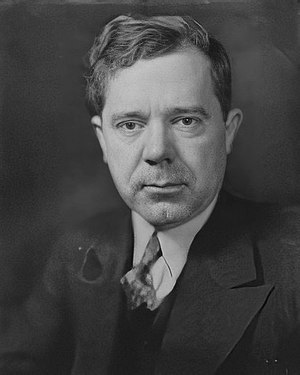Telesphore Bernard
Telesphore Bernard | |||||||||||||||||||||||
|---|---|---|---|---|---|---|---|---|---|---|---|---|---|---|---|---|---|---|---|---|---|---|---|
 Official portrait, 1934 | |||||||||||||||||||||||
| 2nd President of Montesayette | |||||||||||||||||||||||
| In office 8 May 1934 – 6 June 1955 | |||||||||||||||||||||||
| Deputy | Horace Fournier Esmé Albert Dominique Tremble | ||||||||||||||||||||||
| Preceded by | Eugène Dieulafoy | ||||||||||||||||||||||
| Succeeded by | Adelard Béranger | ||||||||||||||||||||||
| Montesayettean Senator from Lavignole | |||||||||||||||||||||||
| In office 9 March 1925 – 8 April 1934 | |||||||||||||||||||||||
| President | Eugène Dieulafoy | ||||||||||||||||||||||
| Preceded by | Thibault Linville | ||||||||||||||||||||||
| Succeeded by | Arienne Sartre | ||||||||||||||||||||||
| |||||||||||||||||||||||
| Personal details | |||||||||||||||||||||||
| Born | Telesphore Bernard August 30, 1893 Clermont-Ferrand, Lavignole, Quebecshirite Montesayette | ||||||||||||||||||||||
| Died | September 10, 1991 (aged 98) | ||||||||||||||||||||||
| Resting place | Clermont-Ferrand, Lavignole, Montesayette | ||||||||||||||||||||||
| Political party | Social Democratic Party | ||||||||||||||||||||||
| Spouse(s) | Thérèse Marie (m. 1913; died 1970) | ||||||||||||||||||||||
| Children | 3; including Emmanuel | ||||||||||||||||||||||
| Relatives | Bernard family | ||||||||||||||||||||||
| Education | Université Nerfoy-Dauphine | ||||||||||||||||||||||
Telesphore Bernard (Quebecshirite: ![]() /te.lɛs.fɔʁ bɛʁ.naʁ/; 30 August 1893 – 10 September 1991), byname "Le Navigateur" (the Navigator), was a Montesayettean barrister and statesman who served as the 2nd president of Montesayette from 1934 to 1955. During his presidency, Bernard focused on managing the country during the Creeperian Civil War and the South Ecros War. He implemented sweeping economic reforms to modernize Montesayette. His economic policies, known as "Bernardomics," created a strong middle class in Montesayette that still remains today. He also created the National Provident Fund.
/te.lɛs.fɔʁ bɛʁ.naʁ/; 30 August 1893 – 10 September 1991), byname "Le Navigateur" (the Navigator), was a Montesayettean barrister and statesman who served as the 2nd president of Montesayette from 1934 to 1955. During his presidency, Bernard focused on managing the country during the Creeperian Civil War and the South Ecros War. He implemented sweeping economic reforms to modernize Montesayette. His economic policies, known as "Bernardomics," created a strong middle class in Montesayette that still remains today. He also created the National Provident Fund.
Part of his strategy also involved restructuring welfare programs and moving away from isolationism, recognizing the need for sustainable policies in the long term. His reforms likewise included reducing government spending, cutting taxes, and introducing competition to the market. He opened up the economy to foreign competition and encouraged free trade, stimulating economic growth, increasing employment, and attracting foreign investment. The reforms also helped reduce government corruption and laid the foundation for a more stable economy. He has been widely recognized as the second founding father of Montesayette, after Eugène Dieulafoy, for his leadership in transforming an underdeveloped country into a thriving industrialized nation, turning vast grasslands and rocky mountains into a developed and prosperous state. His policies have had a lasting impact, shaping the country's economy and society, and remain in place today.